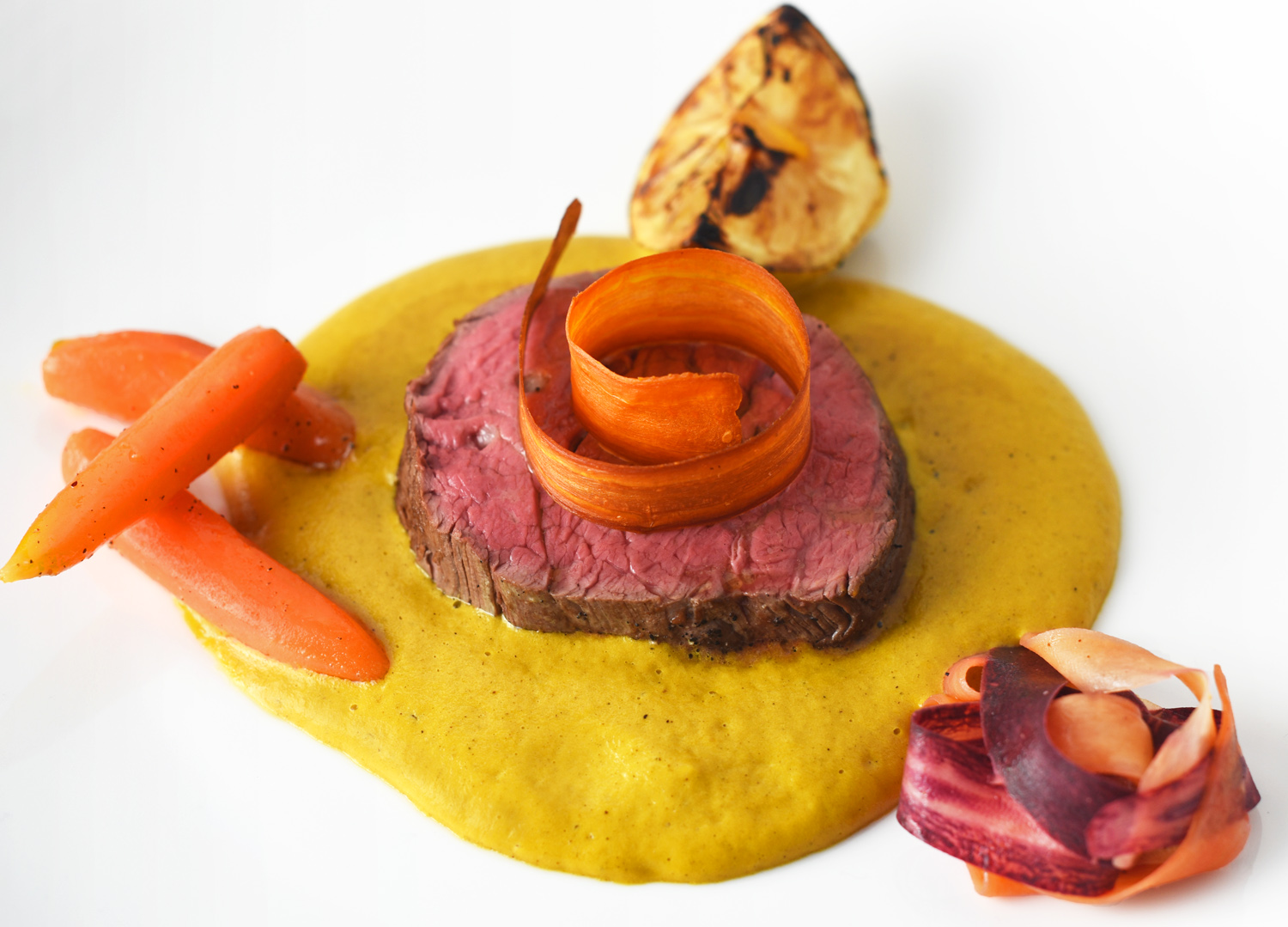Svíčková, which you might remember from my review of Bohemian Spirit Restaurant, is a curious dish. Take its name, for example. The recipe’s full name in Czech is svíčková na smetaně, meaning tenderloin with cream. Literally, svíčková means little candle, and is used to designate the tenderloin — because of its shape. Obviously. But in many cases, a svíčková na smetaně is not made of tenderloin. Through some unknown transformation, the term has come to refer with equal importance to the sauce, with the meat being pretty much any kind of beef roast that’s larded, marinated, braised with the other ingredients, and sliced before serving. In fact, some people enjoy the sauce even if they don’t eat meat. The svíčková sauce itself is a Czech classic that has its own Wikipedia page. So… is this just a simple gravy with cream? Of course not! It’s made not only with cream, but also with an assortment of root vegetables (passed through a sieve at the end of the cooking to give the sauce its characteristic color and texture), vinegar, lemon juice, sugar, and a few herbs and spices. It is thick and rich, in the purest tradition of Czech cuisine.
This story of a cut of beef turned cream sauce, which you won’t find with any statistical significance anywhere outside of Czech Republic, gives svíčková the status of National Dish in many people’s opinion. It’s also made with typically Czech ingredients — beef, bacon, root vegetables, sour cream. You can read this article for more details about what makes it so special, but how did this dish come to be in the first place?

Portrait of Magdalena Dobromila Rettigová by Jan Vilímek
By now, I’ve read a lot of recipes, written over nearly two centuries, in order to retrace the peculiar history of svíčková, and still I don’t have all the answers. But let’s look at some classic recipes in the existing literature:
- In her famous Domácí kuchařka, first published in 1826, Magdalena Dobromila Rettigová gives several recipes for beef tenderloin: larded, cooked and marinated in tons of wine vinegar, then baked “like a hare” and topped with sour cream; baked as previously, but topped with a gravy thickened with an egg yolk and sour cream liaison, and fried breadcrumbs; stewed with onion, spices and herbs (ginger, pepper, thyme, bay leaves), beef stock, vinegar and red wine, then garnished with lemon cakes or lemon cookies (!!!); or stewed as previously, but finished with lemon juice and sugar, and topped with fried breadcrumbs. Most recipes can be eaten hot or cold (accompanied with vinegar and oil, in the latter case). Keep in mind there was no refrigeration in Rettigová’s time! No root vegetables anywhere in these recipes, but we already see some elements shared with today’s svíčková: the larding; the use of lemon, sugar, sour cream, and vegetables (onions) passed through a sieve.
- Marie Svobodová’s Kuchařská škola, published in 1894, mentions cooking a larded beef tenderloin in a lot of butter (or kidney fat), baking it in the oven and topping it with sour cream, with the declared intent to avoid drying out the meat. It’s still just a roast, but compared to Rettigová’s Death By Vinegar, it seems incredibly modern.
- A similar recipe for a “Larded Roast Beef with Sour Cream” can be found in Joza Břízová’s Vaříme Zdravě, Chutně a Hospodárně, a very popular Czech cookbook first published in 1954 (and also available in English). But then the book also lists two recipes for svíčková: svíčková na zelenině (tenderloin with vegetables), where onion, carrot, parsnip and celery root, are eventually pressed through a sieve to make the gravy; and svíčková na smetaně (tenderloin with sour cream), which is the same but with sour cream blended into the gravy. Apparently, the dish was first prepared with root vegetables only, and later with both root vegetables and cream, which explains why it became known as just svíčková na smetaně even though it contains a lot more than just sour cream. This is the first recipe I found that really resembles today’s svíčková, but the intermediary steps of the historical transformation remain murky.
- More recent recipes add lemon juice and sugar to the sauce, and sometimes the extra step of marinating the meat and the vegetables in vinegar overnight (rather a step backwards, in the era of refrigeration). In The Food & Cooking of Eastern Europe, Lesley Chamberlain describes a “candle roast” made that way (without a marinade), where “optional extras are a dash of mustard and Madeira wine”. Peter Trnka’s The Best Of Czech Cooking offers another such canonical svíčková, with the expected larded tenderloin, root vegetables, spices, lemon juice, sugar, and sour cream. In fact, I use almost the same ingredients as Trnka does, though sometimes prepared differently and in different amounts, and without marinating (which in my opinion achieves nothing beyond making the meat taste sour).
- Then came The Internet! Many online recipes, like this one, started exhibiting the bizarre habit of garnishing the svíčková plate with a piece of lemon, cranberries, and whipped cream, usually stacked together (um… so you can remove them from your plate all at once?). Allegedly, “to complete the dish and create a perfect harmony of tastes, it has to be garnished with a slice of lemon, cranberries and scoop of whipped cream.” I sort of get where it all comes from: the sauce already contains lemon and cream; cranberries are often served with venison dishes; so the idea is that one can never have too much of a good thing. Now, every Internet cook and most restaurants seem to think that these things are must-haves, but I don’t know how the trend began.
- Finally, in Eva Filipová’s Czech Cuisine: A Modern Approach, the chef Jaroslav Sapík draws some of the same conclusions as I do, specifically that stewing a beef tenderloin is a terrible waste. Instead, he makes the sauce first, and then roasts the tenderloin separately to a nice pink. Sapík’s recipe is otherwise pretty classic, save for the addition of Worcesterchire sauce and speck to the sauce (perhaps to replace the larding bacon in the tenderloin), the herb dumplings substituting for the more common plain knedlík, and his own interpretation of that whimsical lemon/cranberry/whipped cream trinity mentioned above.

I wanted to create a recipe that preserved the sacrosanct status of the svíčková sauce, while giving the meat a proper treatment, and rejecting some of the traditions associated with the dish that don’t make sense to me:
- First, the meat. I stick with tenderloin because it’s so central to the dish’s origin, but I find it absurd to cook beef’s most tender cut in a stew. Sure, maybe it was safer to marinate and extensively cook a tenderloin butchered from some old cow circa 1826 when refrigeration didn’t exist. Nearly two hundred years later, however, I’m going to just sear the meat and then cook it sous-vide with some butter, keeping it a beautiful pink. Note that this method is in fact very close to what Marie Svobodová recommended over a century ago: that the meat be cooked in butter and baked slowly so that it doesn’t dry out.
- Many people insist that a proper svíčková must cook forever (without having made one themselves, I’d wager). Overnight is the bare minimum, from what I’m hearing. A whole day gets you a few more nods of approval, but two to three days is where true admiration starts showing. You could easily start to think that it should stay on the stove for a whole week! To please such people, even remotely, I still prepare the sauce like a stew, cooking the root vegetables with marrow bones for a few hours — there’s some merit to doing this much, I can’t deny. Adding carrot juice (some of it at the end of the cooking) proves beneficial for several reasons: it adds a fresher carrot note to the stewed flavors, it doesn’t make the sauce thicker like the root vegetables do, and it gives the sauce a more vibrant color. It was particularly important to me to create a sauce that’s truly addictive, and it took me a long time to perfectly balance the meatiness from the marrow bones, the earthiness from the vegetables, and the acidity from the cream and lemon juice. Feel free to one-up your friends by cooking that sauce even longer (just add some water), but I don’t think it will make any difference. What does make a difference, on the other hand, is using a siphon to make the sauce airier. I know your grandmother didn’t have one of those — her loss, my gain. The recipe below makes a bit of extra sauce, which is perfect for mopping.
- Back to the carrots. In an arguably sacrilegious move for Czech cuisine, I decided that the dish needed more vegetables. So I’m proposing different variations on the humble carrot: carrot chips, carrots à l’étuvée, and a raw carrot salad. If you find carrots of different colors, take the chance to diversify the color palette on your plate.
- Any self-respecting svíčková comes with knedlíky (bread dumplings) or with potatoes. As far as I’m concerned, no Czech dumpling will ever be half as tasty as a good French baguette. And a baguette works just as well to mop up the sauce. (Believe it or not, Americans: bread is not just for stuffing yourselves at restaurants before your appetizers arrive). Get the best baguette you can find, because if your bread sucks you’ll miss the point. I don’t think potatoes work as well, neither boiled nor as potato pancakes.
- Then there’s that lemon/cranberry/whipped cream business. It serves little to no purpose; there’s cream and lemon in the sauce already, and the cranberries would just add more acidity. It’s highly impractical and isn’t actually meant to be mixed into the sauce — are you really gonna grab a sauce-and-whipped-cream-covered slice of lemon with your fingers? It doesn’t even look that pretty, though I suspect that the restaurants where’s it’s served that way think otherwise. I’m keeping only some lemon here, and I serve it charred (I think charring the lemon makes its juice taste less acidic). I’m still not sure it’s needed, but go ahead and try squeezing a few drops. If nothing else, call it my homage to Rettigová’s extravagant lemon garnishes. Had I completed my research a little bit sooner, maybe I would have tried replacing it with one of those lemon cakes!
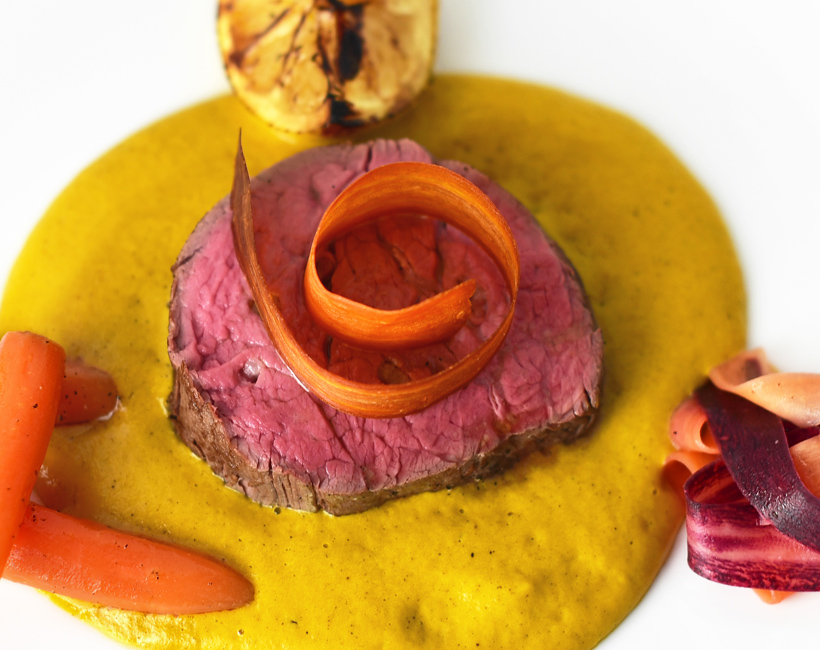
Svíčková sauce
Yields over 4 servings
320 g beef marrow bones
salt
15 g olive oil
40 g peeled onion, medium dice
100 g peeled carrot, medium dice
60 g peeled parsnip, medium dice
60 g peeled celery root, medium dice
0.4 g ground black pepper
0.8 g ground allspice
10 g Dijon mustard
80 g red wine
2 g thyme sprigs
0.2 g bay leaves
120 g veal stock
140 g carrot juice
80 g crème fraîche
1.5 g sugar
8 g lemon juice
- Soak the marrow bones in a bowl of water for 30 minutes, changing the water once or twice. Drain and pat dry.
- Season the bones with salt, and sauté with half of the olive oil in an ovenproof pot over medium heat, until brown on all sides. Reserve.
- In the same pot still over medium heat, sauté the onion, carrot, parsnip, and celery root in the remaining oil until golden brown, stirring regularly.
- Add the black pepper, allspice and mustard, and cook for 2 minutes, stirring constantly. Add the red wine, and reduce to a third.
- Return the marrow bones to the pot.
- Tie the thyme sprigs and bay leaves in a piece of cheesecloth and add to the pot, then add the veal stock and half of the carrot juice. Bring to a simmer.
- Cover with a lid left slightly ajar, transfer to a 120 C / 250 F oven, and cook for 3 1/2 hours, stirring once or twice during that time.
- Take out the bones and herbs. Scoop the marrow out of the bones, and add it to the sauce along with the rest of the carrot juice. Transfer to a blender, and process until smooth. Rectify the seasoning if needed.
- Before serving, add the crème fraîche, sugar, and lemon juice. Reheat in a saucepan over low heat. Keep warm.
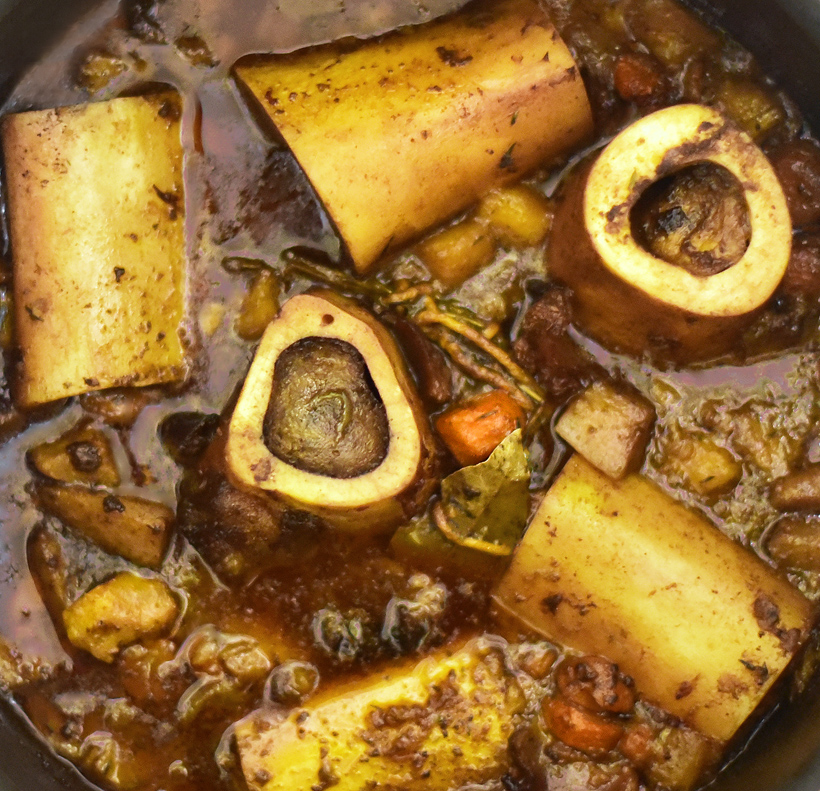
One of my early batches of svíčková sauce (yours will have fewer marrow bones)
Svíčková meat
Yields 4 servings
18 g (about 1 rasher) smoked bacon
500 g beef tenderloin roast
5 g salt
about 15 g canola oil
black pepper, ground
20 g butter
- Cut the bacon into thin strips about the same length as the beef tenderloin. Using a larding needle, lard the tenderloin with the bacon. (Never used a larding needle before? Get one here, and watch this video. Basically, you attach a bacon strip to the jaws of the larding needle, run the needle through the roast lengthwise, and leave the bacon strip inside once the needle comes out at the other end.)
- Season the roast with salt on all sides. Heat the canola oil in a pan over very high heat, then sauté the tenderloin until brown on all sides. Remove from the heat, and season with black pepper.
- Transfer to a sous-vide pouch with the butter, vacuum-seal, then cook in a water bath at 54.5 C / 130 F for 4 hours. Reserve in the water bath until ready to serve.
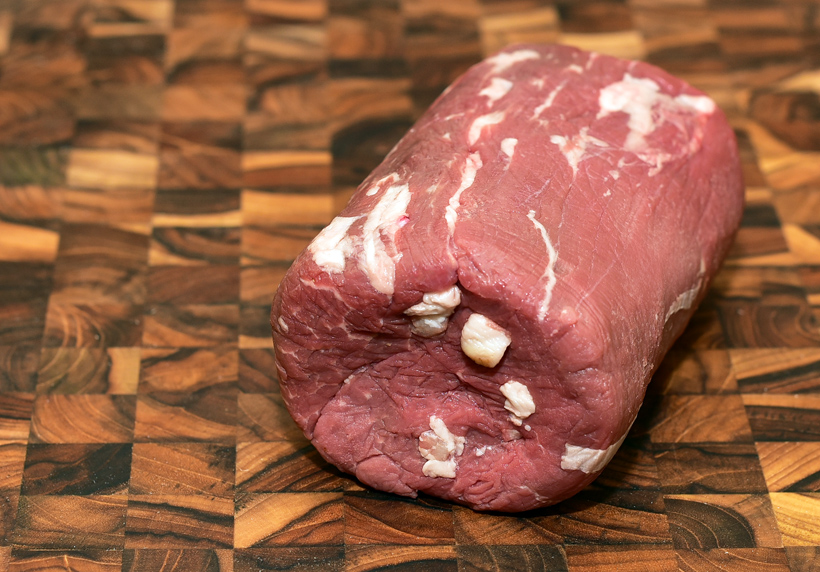
Carrot chips
Yields 4 servings
1 large peeled carrots (about 180 g)
cooking oil spray
salt
- Using a Y-shaped vegetable peeler, peel carrot lengthwise until you get a flat surface. Place the carrot on a board with this flat side down. Peel the other side of the carrot until you get another flat surface. While holding the carrot firmly on the board, use the peeler to make nice long strips, pressing down hard so that the strips are as long and wide as possible. You should get about 80 g of shavings out of this process; pick the 16 nicest strips, and discard the rest (or keep for another recipe).
- Spray two Silpats with cooking oil spray, making two passes. Place the first Silpat on a baking tray, and arrange the carrot strips on top in a single layer, leaving space between them. Cover with the second Silpat, and cook in a 120 C / 250 F oven for 45 minutes. The strips will shrink considerably as they dry into chips.
- When taking the carrot chips out of the oven, immediately transfer to a cooling rack, and give the desired shape before they cool completely. Flat chips are nice, but I opted to roll mine into cylinders in my final plate layout. The chips get hard after a minute, so you won’t be able shape them after that. Reserve the 8 nicest chips, and discard (i.e., eat) the rest.
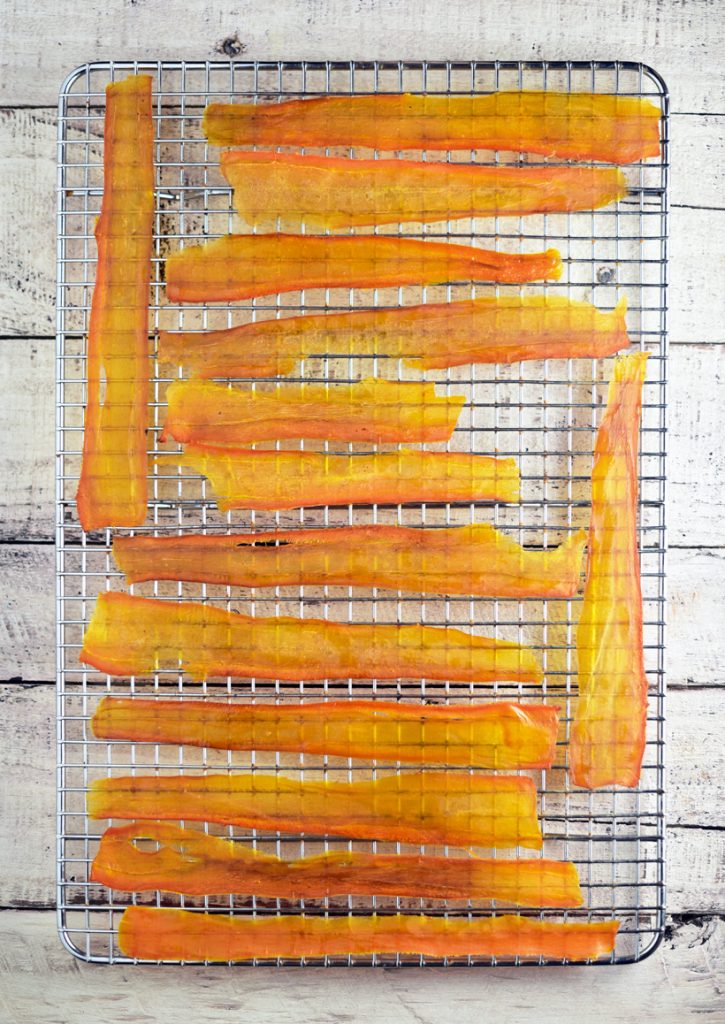
Baby carrots à l’étuvée
Yields 4 servings
200 g peeled baby carrots
20 g butter
20 g orange juice
salt
black pepper, ground
- Place the carrots in a small saucepan with the butter and orange juice, and season with salt and pepper. Cover with a lid, and cook over medium heat for about 20 minutes, until the carrots are tender, stirring occasionally and adding a little bit of water if needed. Reserve.
Carrot salad
Yields 4 servings
60 g peeled baby carrots of various colors
8 g olive oil
8 g lemon juice
salt
black pepper, ground
- Using a Y-shaped vegetable peeler, peel carrots lengthwise into thin slices. You should get around 40 g shavings before the carrots fall apart.
- In a bowl, toss the carrot slices with the olive oil, lemon juice, salt, and pepper. Let rest for 30 minutes.
Charred lemon
1 lemon
cooking oil spray
- Cut the lemon into quarters, and spray all the cut sides with cooking oil.
- Heat a pan over high heat. Cook the lemon quarters on all sides until lightly charred. Reserve.
- Alternatively, you can use 2 lemons and cut them into halves. Lemon halves look slightly prettier but take up more space on your plate.
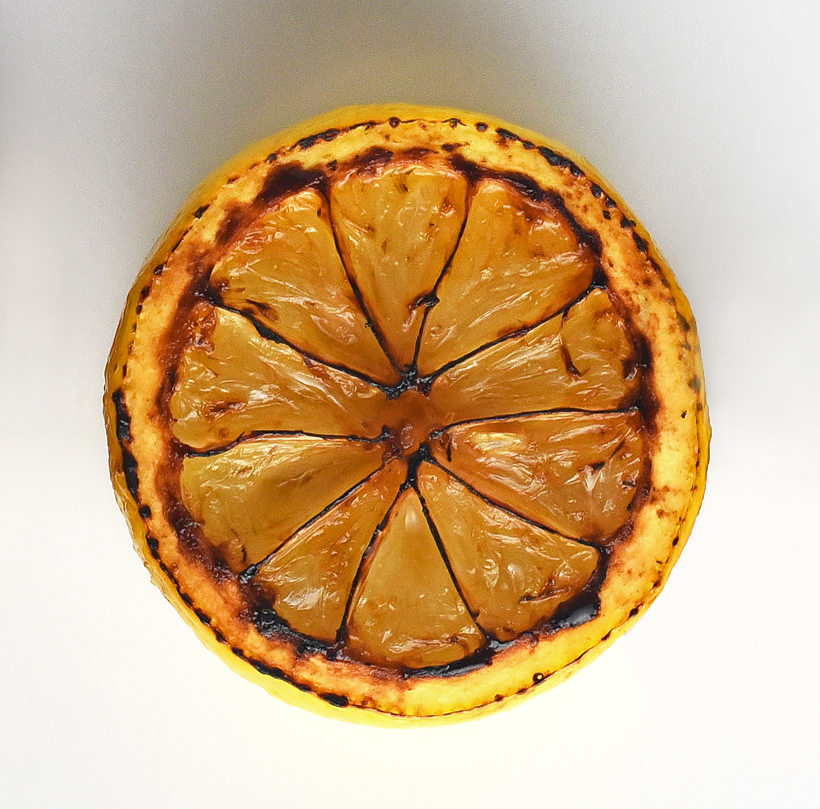
Assembly
Yields 4 servings
svíčková sauce
baby carrots à l’étuvée
svíčková meat
carrot salad
charred lemon
carrot chips
1 French baguette, sliced
- Reheat the svíčková sauce over low heat if necessary. Transfer to a siphon, load with two cartridges of N2O, and shake well.
- Reheat the baby carrots over low heat.
- Take the svíčková meat out of the sous-vide pouch, and cut into 4 slices.
- In the center of each plate, make a disc of sauce using the siphon. Top with a slice of meat, some jus from the sous-vide pouch, and a carrot chip. Garnish the plate with a piece of lemon at 12 o’clock, a small stack of carrot salad at 4 o’clock, and a few baby carrots at 8 o’clock. Serve with slices of baguette on the side.

